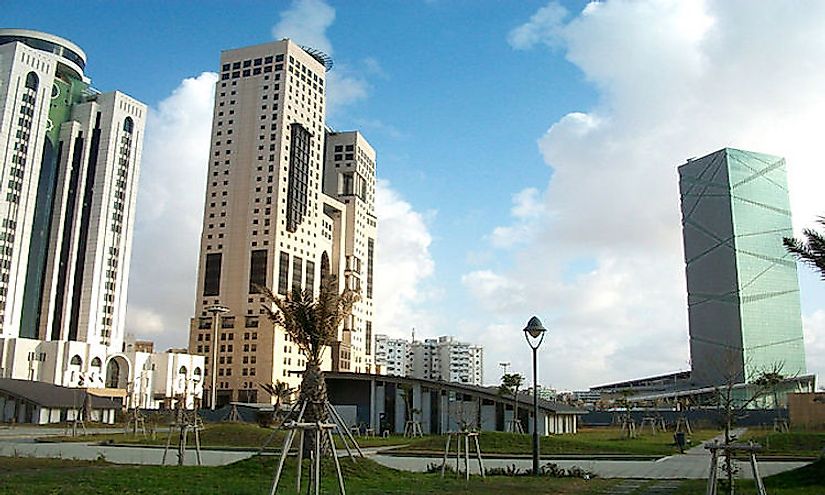Biggest Cities In Libya

Libya is located in North Africa, and a vast section of the nation is occupied by the Sahara Desert. Libya has a long northern coastline with the Mediterranean Sea, which is where most of the country's major cities are located. This article will discuss the location, history and current importance in the three biggest cities in the country.
The Three Biggest Cities In Libya
Tripoli
The capital city of Tripoli is the most populous city in Libya, with a population of 1,188,000 people. The city is located in the Greater Tripoli region. Tripoli is a coastal city that sits in the northwestern part of the country between the Mediterranean Sea and the desert. In the 7th century BC, the Phoenicians founded the city of Oea at the site where Tripoli is located. The city was then taken by the Greeks and the Carthaginians before the Romans took it towards the end of the 2nd century BC. The Roman and later Byzantine Empire control the city until it was taken by the Rashidun Caliphate in 642 or 643. Following this, the city was under various Muslim or Ottoman rule until the Italian invasion barring the period between 1530 to 1551 when the Malta Order of Saint John of Jerusalem (1530-1798) controlled the city. Today the capital of Tripoli is one of the main economic centers of the country and is the leading center for the banking, communication and finance of Libya. The city is home to the Tripoli International Fair, which started in 1927 and is the oldest trade fair in Africa. There is also the Red Castle Museum, which was established in 1919 and is the national museum of Libya. The Arch of Marcus Aurelius, which is a Roman triumphal arch, was built in 165 AD and is the most notable remain of Roman presence in the city.
Benghazi
The city of Benghazi is the second most populous city in Libya, with a population of 665,778 people. The city is located in the Benghazi District. Benghazi is a port city that sits in the northeastern part of the country along the Mediterranean Sea. At some time around 525 BC, the Greeks founded the city of Euesperides at the site where the modern bay city of Benghazi is located and lasted until around the middle of the 3rd century BC when the city was relocated. Shortly after that, the city was refounded under the Ptolemaic Kingdom (305-30 BC) as Berenice and later Hesperides. Following the end of the Ptolemaic Kingdom, the city came under Roman and later Byzantine rule until 643 when it had become a small, unimportant village. After this, the city took the same historical path as Misrata. In 2012 the city was the site of the attack on the American diplomatic mission in Libya, which resulted in 4 deaths and 10 injuries. Benghazi is one of the economic centers of Libya, and its port is vital for importing foodstuffs and manufactured products. The city is also home to the parliament of the country, the National Library of Libya and is the headquarters of Libyan Airlines and the National Oil Corporation.
Misrata
The city of Misrata is the third most populous city in Libya, with a population of 315,500 people. The city is located in the Misrata District. Misrata is a coastal city that sits in the northwestern part of the country along the Mediterranean Sea. The city of Misrata was established in the 7th century as a major caravan center and port under the Rashidun Caliphate (632-661). Following this, the city was ruled by the succeeding caliphates, and in 1551 the city came under the control of the Ottoman Empire (1299-1923). From the 12th century until the 19th century, the city served as a major trading center known throughout the Saharan Region. In 1911, the Italians occupied the city during the Italo-Turkish War (1911-12) and controlled it as a colony until the British took over in 1943 during World War Two (1939-1945). From 1943 to 1952, all of Libya was under British and French control as a protectorate until Libya gained independence. Today Misrata serves as the commercial hub of Libya and is a city that is noted for being well organized in its layout and clean. The city is home to the Misrata University, which was founded in 1938 and four different soccer clubs. It has also had a railway line and port that were recently built.
The Future Of Libya's Population
The population of Libya is currently about 6.3 million people today, close to six times what it was back in 1950 when it was about 1.1 million people. This increase of population has been most notable in the major cities of the country. Based on current projections Libya's population will keep increasing until 2065 when it should hit about 8.52 million.
Biggest Cities In Libya
| Rank | Biggest Cities in Libya | Estimated Population |
| 1 | Tripoli | 1,188,000 |
| 2 | Benghazi | 665,778 |
| 3 | Misrata | 315,500 |
| 4 | Bayda | 250,000 |
| 5 | Khoms | 201,472 |
| 6 | Zawiya | 200,000 |
| 7 | Tobruk | 120,000 |
| 8 | Sabha | 113,436 |
| 9 | Ajdabiya | 105,484 |
| 10 | Sirte | 103,816 |







